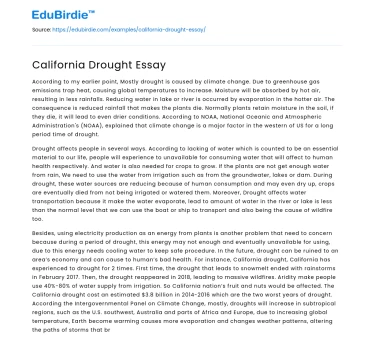Introduction
California's drought has emerged as a significant environmental and socio-economic challenge, attracting the attention of policymakers, scientists, and the public. With its economy heavily reliant on agriculture, which accounts for over $50 billion annually, water scarcity poses a threat to the state's prosperity and sustainability. Climate change exacerbates the situation, with studies indicating an increase in the frequency and severity of droughts. For instance, a report by the California Department of Water Resources highlights that the state has experienced some of the driest years on record in the past decade. As the population continues to grow, the demand for water intensifies, further straining the limited resources available. This essay explores the causes, impacts, and potential solutions to California's drought crisis, offering a comprehensive understanding of one of the state's most pressing issues.
Causes of California's Drought
Several factors contribute to California's persistent drought conditions, with climate change being a primary driver. According to the National Oceanic and Atmospheric Administration (NOAA), rising global temperatures have altered precipitation patterns, leading to prolonged dry spells. This phenomenon is compounded by the fact that California's Mediterranean climate naturally predisposes the state to seasonal variability in rainfall. As a result, even minor deviations from average precipitation levels can have significant consequences.
Save your time!
We can take care of your essay
- Proper editing and formatting
- Free revision, title page, and bibliography
- Flexible prices and money-back guarantee
Another contributing factor is the over-extraction of groundwater resources. In regions like the Central Valley, aquifers are being depleted faster than they can be replenished, exacerbating water scarcity. The California Water Science Center reports that groundwater levels have dropped by more than 100 feet in some areas due to excessive pumping. This unsustainable practice not only diminishes the available water supply but also leads to land subsidence, further complicating water management efforts.
Moreover, inefficient water usage in urban and agricultural sectors has intensified the drought's impact. Despite advancements in irrigation technology, outdated practices still prevail in some regions, leading to significant water wastage. Urban areas, too, have been slow to adopt water conservation measures, with per capita water use remaining high compared to other states. Addressing these inefficiencies is crucial for mitigating the effects of drought and ensuring long-term water security.
Impacts on the Economy and Environment
The economic repercussions of California's drought are profound, particularly in the agricultural sector. As water becomes scarce, crop yields decline, leading to increased prices and reduced competitiveness in global markets. The University of California, Davis, estimates that the drought has resulted in annual economic losses exceeding $2 billion, affecting thousands of jobs and livelihoods. These economic challenges are further compounded by the need for costly infrastructure investments to improve water storage and distribution systems.
Environmentally, the drought has devastating effects on California's ecosystems. Reduced water availability threatens biodiversity, with species such as the Chinook salmon facing habitat loss and increased mortality rates. The California Department of Fish and Wildlife has documented significant declines in fish populations, highlighting the urgent need for conservation efforts. Furthermore, the increased frequency of wildfires, fueled by dry conditions, exacerbates habitat destruction and poses additional challenges for environmental management.
Beyond the immediate impacts, the drought contributes to long-term environmental degradation, including soil erosion and reduced carbon sequestration capacities. These changes have far-reaching implications for the state's ecological balance and underscore the importance of developing sustainable water management practices.
Potential Solutions and Counter-Arguments
Addressing California's drought requires a multifaceted approach that balances immediate needs with long-term sustainability. One potential solution is the implementation of advanced water management technologies, such as desalination and water recycling. Desalination, although energy-intensive, provides a reliable source of fresh water and has been successfully adopted in regions like San Diego. Similarly, water recycling initiatives can significantly reduce dependence on freshwater sources, as evidenced by the success of Orange County's Groundwater Replenishment System.
However, these solutions are not without their challenges. Critics argue that desalination is costly and environmentally damaging, with potential impacts on marine life due to the discharge of brine by-products. Water recycling also faces public skepticism, often referred to as the "yuck factor," which can hinder widespread adoption. To overcome these obstacles, it is essential to invest in public education and transparent policymaking to build trust and acceptance among stakeholders.
Another critical component of drought mitigation is the promotion of water conservation practices. Policies that incentivize reduced water usage, such as tiered pricing and rebates for water-efficient appliances, have proven effective in encouraging conservation. Furthermore, enhancing agricultural efficiency through the adoption of precision irrigation techniques can significantly reduce water waste, as demonstrated by successful pilot programs in the Central Valley.
Conclusion
California's drought presents a complex challenge that necessitates a comprehensive and collaborative response. While climate change and inefficient water management practices have exacerbated the crisis, innovative solutions are within reach. By embracing technological advancements, promoting conservation, and fostering public engagement, California can navigate its water crisis and build a more resilient future. As the state continues to grapple with the impacts of drought, the lessons learned will not only benefit California but also serve as a model for other regions facing similar challenges. Ultimately, a sustainable approach to water management is essential for ensuring the long-term prosperity and well-being of California's communities and ecosystems.






 Stuck on your essay?
Stuck on your essay?

